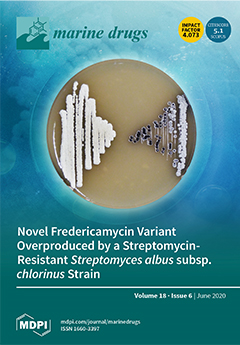The pyrrole-imidazoles, a group of alkaloids commonly found in marine sponges belonging to the genus
Agelas, display a wide range of biological activities. Herein, we report the first chemical study of the secondary metabolites of the sponge
A. dilatata from the coastal
[...] Read more.
The pyrrole-imidazoles, a group of alkaloids commonly found in marine sponges belonging to the genus
Agelas, display a wide range of biological activities. Herein, we report the first chemical study of the secondary metabolites of the sponge
A. dilatata from the coastal area of the Yucatan Peninsula (Mexico). In this study, we isolated eight known alkaloids from an organic extract of the sponge. We used NMR and MS analysis and comparison with existing databases to characterize the alkaloids: ageliferin (
1), bromoageliferin (
2), dibromoageliferin (
3), sceptrin (
4), nakamuric acid (
5), 4-bromo-1H-pyrrole-2-carboxylic acid (
6), 4,5-dibromopyrrole-2-carboxylic acid (
7) and 3,7-dimethylisoguanine (
8). We also evaluated, for the first time, the activity of these alkaloids against the most problematic multidrug-resistant (MDR) pathogens, i.e., the Gram-negative bacteria
Pseudomonas aeruginosa,
Klebsiella pneumoniae and
Acinetobacter baumannii. Bromoageliferin (
2) displayed significant activity against
P. aeruginosa. Comparison of the antibacterial activity of ageliferins
1–
3 (of similar structure) against
P. aeruginosa revealed some relationship between structure and activity. Furthermore, in in vitro assays,
2 inhibited growth and biofilm production in clinical strains of
P. aeruginosa. Moreover,
2 increased the survival time in an in vivo
Galleria mellonella model of infection. The findings confirm bromoageliferin (
2) as a potential lead for designing new antibacterial drugs.
Full article






